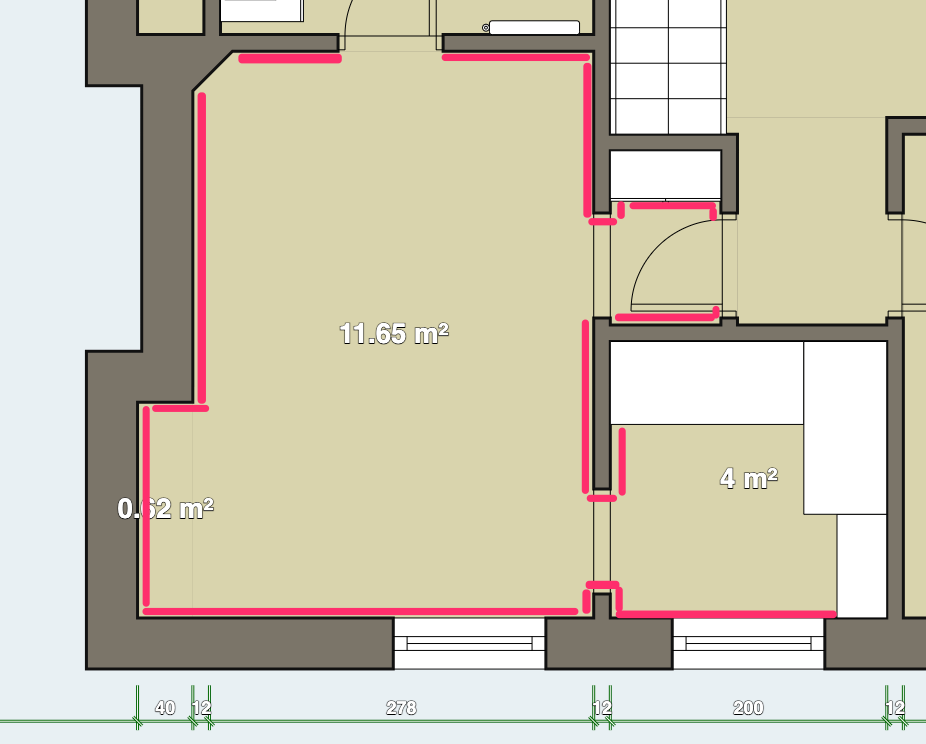We’d like to remind Forumites to please avoid political debate on the Forum.
This is to keep it a safe and useful space for MoneySaving discussions. Threads that are – or become – political in nature may be removed in line with the Forum’s rules. Thank you for your understanding.
📨 Have you signed up to the Forum's new Email Digest yet? Get a selection of trending threads sent straight to your inbox daily, weekly or monthly!
Allay my fears about fitting skirting boards!
greensalad
Posts: 2,530 Forumite






As part of our bedroom redecoration we decided to rip off all the skirting boards. We had made some changes to the upstairs layout which meant we had to remove some of them and I couldn't find a decent match, plus they were in fairly poor condition. We are planning to put them back on ourselves, to try and save money and time. We have carpet fitting booked in 3 weeks so they have to be in.
The room is not at all easy, it's not just 4 pieces of skirting but 19! So I know we've probably bitten off more than we can chew but I'm hoping we can make it work...
I've read into how to scribe internal corners. We've invested in a sliding mitre saw to do 45 degree angles for external corners (there are quite a few) and help with chopping the lengths. The walls are fairly straight, as luckily the upstairs was built pretty nicely. We were planning to use grip filler and headless nails which we'll do by hand rather than buying another tool (nail gun).
I'm pretty good at measuring up, which I think is the thing that worries my partner. I've ordered one extra length of skirting than we need at £25 just so we have extra in case we muck some cuts up (which we inevitably will).
Please tell me it's not going to be too difficult, I am confident but my partner it all doom and gloom!
The room is not at all easy, it's not just 4 pieces of skirting but 19! So I know we've probably bitten off more than we can chew but I'm hoping we can make it work...
I've read into how to scribe internal corners. We've invested in a sliding mitre saw to do 45 degree angles for external corners (there are quite a few) and help with chopping the lengths. The walls are fairly straight, as luckily the upstairs was built pretty nicely. We were planning to use grip filler and headless nails which we'll do by hand rather than buying another tool (nail gun).
I'm pretty good at measuring up, which I think is the thing that worries my partner. I've ordered one extra length of skirting than we need at £25 just so we have extra in case we muck some cuts up (which we inevitably will).
Please tell me it's not going to be too difficult, I am confident but my partner it all doom and gloom!
0
Comments
-
MDF? Usually easier to work with, more stable, doesn't 'cup', easier to finish.
And I'd give serious consideration to also mitreing the internal corners. Not the 'correct' way, but with a stable material like MDF, there's no reason I can think of why not.
Also perhaps consider using an adhesive such as 'mitre bond' on small sections, complex returns, etc. Cut and mitre the pieces, and - when happy - glue some sections together before them sticking them in place.
There's some superb adhesives now for fixing skirting boards - I think my chippie used a spray foaming adhesive? Nails only required as a temp measure until adhesive sets.
If you have a good quality mitre saw, set correctly at the required 90o, you should find this very enjoyable. And any wee gaps, get them in the internal corners, and simply fill afterwards. (But try and have the mitres actually adhered together, so filler is purely surface- cosmetic).0 -
greensalad said:
Please tell me it's not going to be too difficultIt's not going to be difficult. Like a lot of DIY tasks, it will be time-consuming (especially making the scribed joints), but just take your time, don't rush things, and it's not at all difficult. And remember the old maxim - measure twice, cut once.There's a handy guide here https://www.diy.com/ideas-advice/how-to-fit-skirting-board/CC_npci_100044.art
2 -

Here's the layout. Pink is the new boards.0 -
Yes 18mm MDF.Bendy_House said:MDF? Usually easier to work with, more stable, doesn't 'cup', easier to finish.Bendy_House said:
And I'd give serious consideration to also mitreing the internal corners. Not the 'correct' way, but with a stable material like MDF, there's no reason I can think of why not.
Oh I am so so so happy you said that because secretly I was wishing I could do it that way and save myself so much agro, especially as I'm planning to use ogee which is... curvy. I was honestly dreading it but thought it was the "done" way. I know they say it can cause problems due to non-square corners and movement, but isn't that what caulk is for?!
I was planning to buy nails just as an in-case and see how it goes. Unlike other areas in the house, there don't seem to be too many bulges in the wall so I'm hoping we can just press it up against and get good adhesion.
1 -
A mitre saw will cut internal and external angles. Think about it logically, if you cut and external angle i.e. 135 degrees, the cut on the remaining timber is 45 degrees.
0 -
Yeah I'm aware it's doable with the saw, my issue was all tutorials were suggested it had to be scribed instead and that was the "proper" way to do it to a) stop shrinkage of the joints away from each other and b) because internal corners are not always perfectly square. However this room being a bit less old and timber/stud construction seems to be much much squarer than my 50 year old extension which we had to get someone in for skirtings, and even he found it a bit difficult and had to screw into the wall to get it to curve around bulges in the plaster.TELLIT01 said:A mitre saw will cut internal and external angles. Think about it logically, if you cut and external angle i.e. 135 degrees, the cut on the remaining timber is 45 degrees.1 -
We replaced old skirting in all the rooms in our last house, where no rooms were square.
A digital angle finder will be worth every penny and a sliding mitre as well as caulk.
I scribed internal angles because I found it easier on odd angles, I actually made a router template from ply for the repeated scribed ends.
I did the first room in MDF but hated the plasticky look & having to wear a mask so used real wood for the other rooms.
1 -
greensalad said:
Yes 18mm MDF.Bendy_House said:MDF? Usually easier to work with, more stable, doesn't 'cup', easier to finish.Bendy_House said:
And I'd give serious consideration to also mitreing the internal corners. Not the 'correct' way, but with a stable material like MDF, there's no reason I can think of why not.
Oh I am so so so happy you said that because secretly I was wishing I could do it that way and save myself so much agro, especially as I'm planning to use ogee which is... curvy. I was honestly dreading it but thought it was the "done" way. I know they say it can cause problems due to non-square corners and movement, but isn't that what caulk is for?!
I was planning to buy nails just as an in-case and see how it goes. Unlike other areas in the house, there don't seem to be too many bulges in the wall so I'm hoping we can just press it up against and get good adhesion.That's all good.The only other issue that can make it trickier than expected is if the wall isn't nicely flat and vertical. It's not uncommon for the plaster skim to thin out - taper - behind skirting boards, so when you press the boards tight against the wall, it actually goes in slightly at the bottom, so the skirtings 'lean' outwards - that'll really mess with your mitres and your head. You want these boards nigh-on perfectly vertical, and hopefully that also means at right angles to the floor!So, systematic approach. Start at one end and start your cutting. Test them in place; use a Try-square on the floor to check each section is sitting 'square', vertical to, the floor. If any do not, then work out what's needed as a packing piece, and stick the odd one on the back of the length so that you CAN just push the board up tight and it'll be correct. Once happy with each section, temp secure it in place by, say, banging in long 2mm panel pins every metre or so, but don't drive them home - this is just a temp measure.When you are happy you have a nice run of pieces and wish to secure them permanently, then gently pull the pins out enough to release the boards, apply whatever adhesive you consider best for the job, definitely a bead of ditto along the mitre surfaces, and fit them in place tapping the pins back in - but again I wouldn't bother driving them fully home, just enough to hold the boards while the adhesive sets.External corners - once you know each piece is the right size, then consider pre-gluing the mitres, but that's for you to decide if that's an advantage. One trick I used to do was to lay the pieces that made up a complex little 'step' - you have at least three of these - down flat on the floor, outer face upwards. Press them against a straight edge so's you know they are perfectly in line. Then I'd stick down a couple of strips of wide masking tape along them to bind them together in line. Turn it over, run a bead of adhesive in to the mitre valleys, and gently fold up the end pieces - the masking tap will (should...) 'hinge' them together neatly. Stand the part upwards as it will be fitted, and check the angles are perfect using the try square. Hold them together using another strip of masking tape until glue set. You 'should' end up with the 'complex' section pre-assembled like this, ready to slip into place.Or, if you need to, you can carefully (may need a pilot hole, or thinner p'pins so as not to split the MDF) drive a couple of pins in to the face of one board piece, 10mm in from the very end of the mitre tip, and gently drive the pin in to the cut end of the next 90o piece. Does that make sense? Ie, hold the two pieces of the ext mitre in place, and gently drive a pin through from one 'face' in to the other's 'end'. As the pin tip makes contact with the second piece, you will need to have the two board pieces held firmly so they align as the pin bites. Again, this is a temp measure - don't drive the pins home. Mitre-glue.These are all Mickey-Mouse methods, the sort of stuff you resort to when things get tricky. You will no doubt work out what's good for you!0 -
Anybody used this?: https://www.toolstation.com/soudal-genius-gun-plasterboard-adhesive-foam/p99304It'll certainly be strong enough...Oh, another tip - get together a selection of heavy objects - bricks, paint tins, heavy books, etc, ideally things that are 'square', and use these to hold the lengths in place while the adhesive sets. Really, no need for pins to actually secure the skirting, but they are useful to temp hold the lengths in place.I usually remove the pins after the adhesive has set - hence not driving them home. A few reasons - if you try and hammer them home, there's a very good chance the pin will hit something hard and buckle... grrrrr. You can also push the board in further than you may wish - if there are gentle undulations in the wall, you'll want a balance between following them, and compensating for them with a little more caulk along the top. With pins driven home, that choice has gone. And, you'd need to drive the heads below surface level before filling, and there's a chance a rust spot will form afterwards. So, I pull 'em out, and then fill the wee empty hole.
0 -
Well I did some skirting board in my kitchen and hallway once. I also used a mitre saw. In some cases the walls weren't entirely straight but with a bit of creativity I got them absolutely perfect. I didn't use nails, I think I just glued them, but they were fairly short lengths. It took me a long time and there were only 4 pieces that I recall. 2 of them ended up being hidden by the fridge lol.
1
Confirm your email address to Create Threads and Reply

Categories
- All Categories
- 352.3K Banking & Borrowing
- 253.7K Reduce Debt & Boost Income
- 454.4K Spending & Discounts
- 245.4K Work, Benefits & Business
- 601.1K Mortgages, Homes & Bills
- 177.6K Life & Family
- 259.2K Travel & Transport
- 1.5M Hobbies & Leisure
- 16K Discuss & Feedback
- 37.7K Read-Only Boards



